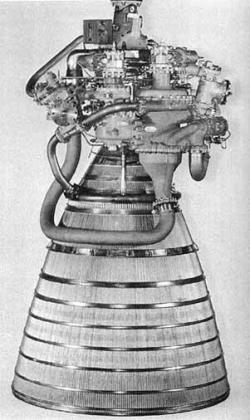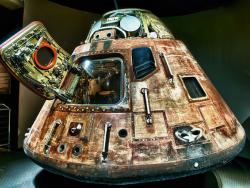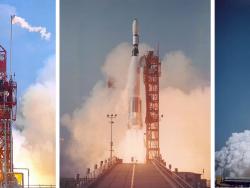The RL-10, which served as the power plant for NASA's upper-stage Centaur space launch vehicle, was the first rocket engine to use high-energy liquid hydrogen as a fuel. It has provided precisely controlled, reliable power for lunar and planetary explorations. The RL-10 embodied numerous advanced design features, including multiple use of its fuel with the "bootstrap cycle." The RL-10 is also capable of multiple restarts in space, which enables positioning of satellites or further escape of Earth's gravity.
Booster

YearAdded:
Image Credit: Public Domain (NASA)Image Caption: The first rocket engine to use high-energy liquid hydrogen as fuel.Era_date_from: 1958
1979

The Atlas E-2 Space Booster, or launch vehicle, is a modified intercontinental ballistic missile developed by the Convair Division of General Dynamics and the U.S. Air Force. The basic concept of the Atlas system was proven in its first flight on June 11, 1957, followed over the years by the launching more than five hundred vehicles including the Pioneer, Ranger, Mariner, and Surveyor. Many payloads were sent into orbit as detachable sections of Atlas missiles.
YearAdded:
Image Credit: All 3 images are Public DomainImage Caption: A compilation of three successful launches vehicles in action. On the left is the Atlas-Centaur, the center is the Atlas-Agena, and the right is the SM-65A Atlas missile.Era_date_from: 1957
1985

6225 Vectorspace BlvdTitusvilleState: FLZip: 32780Country: USAWebsite: http://www.asme.org/about-asme/history/landmarks/topics-a-l/air-and-space-transportation/-162-apollo-space-command-module-%281968%29, http://nssdc.gsfc.nasa.gov/planetary/lunar/apollo14info.htmlCreator: North American Aviation
The Apollo was the vehicle that first transported humans to the moon and safely back to earth. Nine lunar flights were made between 1968 and 1972. The command module, built by North American Aviation (at the time of launch, North American Rockwell Corporation), accommodated three astronauts during the mission. It was the only portion of the Apollo spacecraft system designed to withstand the intense heat of atmospheric re-entry at 25,000 mph and complete the mission intact. This command module at Rockwell flew as Apollo 14 in 1971.
YearAdded:
Image Credit: Courtesy Flickr/Chad Nordstrom (CC BY 2.0) Image Caption: The real Apollo Space Command Module on display at the Kennedy Space Center's Saturn V Building.Era_date_from: 1968
1992
Innovations

The Apollo was the vehicle that first transported humans to the moon and safely back to earth. Nine lunar flights were made between 1968 and 1972. The command module, built by North American Aviation (at the time of launch, North American Rockwell Corporation), accommodated three astronauts during… Read More

The Atlas E-2 Space Booster, or launch vehicle, is a modified intercontinental ballistic missile developed by the Convair Division of General Dynamics and the U.S. Air Force. The basic concept of the Atlas system was proven in its first flight on June 11, 1957, followed over the years by the… Read More

The RL-10, which served as the power plant for NASA's upper-stage Centaur space launch vehicle, was the first rocket engine to use high-energy liquid hydrogen as a fuel. It has provided precisely controlled, reliable power for lunar and planetary explorations. The RL-10 embodied numerous…
Read More

